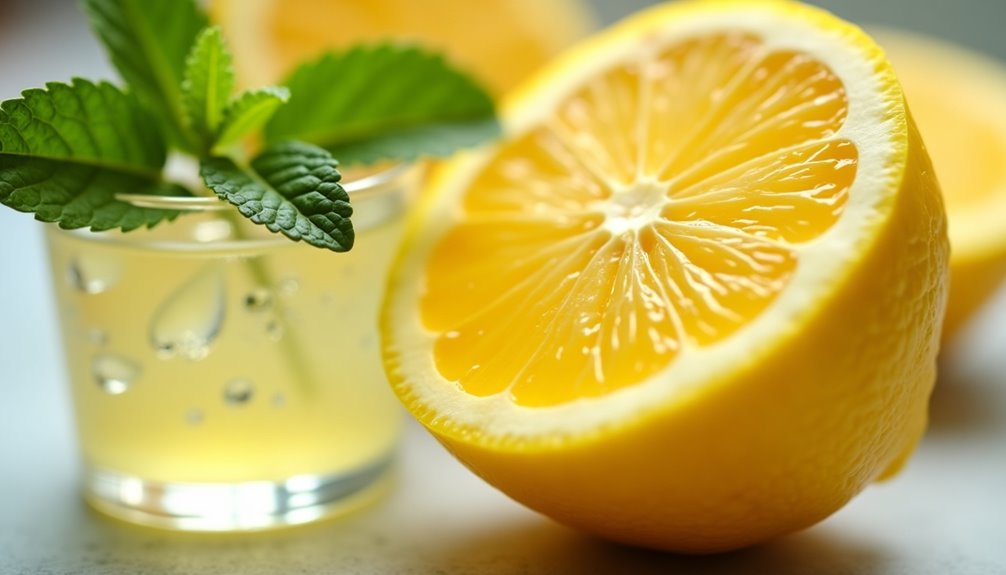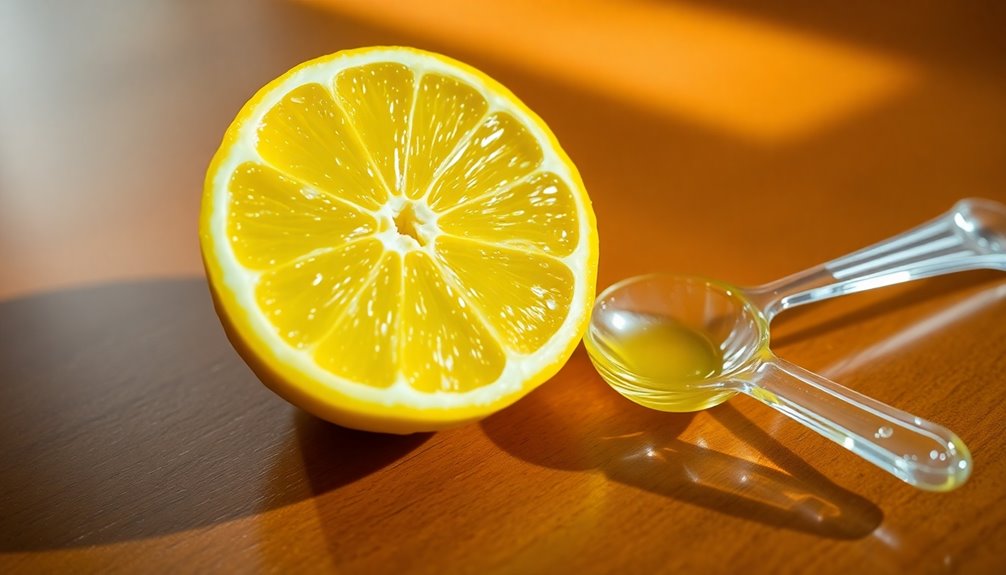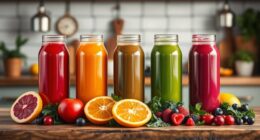When you cut half a medium lemon, you can expect about 1½ tablespoons of juice. If it's a large lemon, that half will yield around 2 tablespoons. The amount can vary depending on factors like size and ripeness, so ripe lemons usually provide more juice. If you're planning to use lemon juice in a recipe, have extra lemons on hand. Keep going to discover tips on maximizing your juice extraction!
Key Takeaways
- Half a medium lemon yields approximately 1½ tablespoons of juice.
- Half a large lemon produces around 2 tablespoons of juice.
- The actual yield may vary based on the lemon's size, ripeness, and variety.
- Ripe lemons typically contain more juice than under-ripe ones.
- Using a juicer can maximize the juice extracted from half a lemon.

When you're cooking or mixing drinks, knowing how much lemon juice to expect from half a lemon can be really helpful. You might be surprised to find that half a medium lemon typically yields about 1½ tablespoons of juice. If you're using a large lemon, you can expect around 2 tablespoons from that same half. This knowledge can make a big difference when you're following recipes that call for specific amounts of lemon juice.
The yield can vary based on a few factors, including the size, ripeness, and variety of the lemon. A ripe lemon usually has more juice compared to an under-ripe one. So, if you grab a lemon from the store, keep in mind that its juiciness may differ.
If you want to maximize the amount of juice you get from your lemons, using a juicer can be a smart choice. A juicer helps extract every last drop, ensuring that you're not left with any wasted juice clinging to the lemon's insides.
When you're preparing recipes that require lemon juice, it's wise to consider these yields. If a recipe calls for a specific number of tablespoons and you only have medium lemons, you might need to adjust the number of lemons you use. For instance, if your recipe asks for 3 tablespoons of lemon juice, you'll know you'll need at least two medium lemons to get what you need, assuming one yields about 1½ tablespoons. If you're using large lemons, just one will likely suffice.
It's also a good idea to keep extra lemons on hand, especially if you're experimenting in the kitchen or preparing a drink that needs a bright, zesty kick. You never know when you might need a little extra juice for balance. The last thing you want is to realize you're short on lemon juice halfway through your cooking or mixing process.
You might find that some recipes work better with a little more or a little less juice than specified. So, if you love a tangy flavor, feel free to adjust the amount to suit your taste. Just remember, the goal is to enhance the overall flavor without overpowering the dish or drink.
Frequently Asked Questions
How Much Juice Is in Half a Lemon?
When you're trying to figure out how much juice is in half a lemon, it generally depends on the lemon's size and ripeness.
You can expect about 1½ to 2 tablespoons from half a medium to large lemon.
Keep in mind that some lemons might yield less, so it's smart to have a couple of extras on hand.
This way, you'll ensure you've got enough juice for your recipe without any surprises!
Can I Substitute Bottled Lemon Juice for Fresh Lemon Juice?
Sure, you can substitute bottled lemon juice for fresh, but why would you?
It's like choosing a store-bought cake over a homemade one. While bottled juice is convenient, it often lacks the vibrant flavor of fresh juice, which can elevate your recipes.
If you decide to go that route, start with less, and taste as you go. You might just find that fresh lemon juice is worth the extra squeeze after all!
How Much Concentrated Lemon Juice Equals Half a Lemon?
When you're looking to substitute concentrated lemon juice for half a lemon, you'll want to use about 1½ tablespoons. This amount generally matches the juice you'd get from a medium lemon.
However, keep in mind that the flavor might differ, so it's a good idea to taste and adjust as needed. If you're using a larger lemon, you might need to increase the amount slightly for the best results in your dish.
How Much of Bottled Lemon Juice Is Equal to 1 Lemon?
You might think bottled lemon juice can't match the freshness of a real lemon, but it's a handy substitute!
For one lemon, you'll want to use about 3 tablespoons of bottled lemon juice. Start with 1 tablespoon and adjust to your taste.
Just remember, some brands include preservatives that might alter the flavor, so it's always good to check the label.
You can still whip up delicious dishes with this convenient option!
Conclusion
In conclusion, squeezing half a lemon typically yields about 1 to 2 tablespoons of juice, depending on its size and juiciness. Whether you're whipping up a refreshing drink or adding zest to your dish, that little half lemon packs a punch that can transform your culinary creations! So next time you reach for a lemon, remember: even a small squeeze can unleash a flavor explosion that'll have your taste buds dancing like there's no tomorrow!
Cindy thoroughly researches juicing trends, techniques, and recipes to provide readers with practical advice and inspiration. Her writing style is accessible, engaging, and designed to make complex concepts easy to understand. Cindy’s dedication to promoting the advantages of juicing shines through her work, empowering readers to make positive changes in their lives through the simple act of juicing.
















